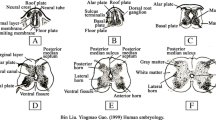Abstract
The expression of the 3-fucosyl-N-acetyl-lactosamine (FAL, CD15, Lex) epitope has been examined immunohistochemically in paraffin sections of the brainstem of the mouse. The initial appearance of labelling was at embryonic day (E)11, when immunoreactivity of radial glial fibres was noted in the medulla, pons and dorsal isthmus, while the spinal cord was immunoreactive from E12. Labelling remained faint until E14, when a distinctive radial pattern appeared in the medulla, pons and spinal cord. Immunoreactivity at E14 in both the spinal cord and medulla was strongest in a band in line with the sulcus limitans, passing ventrolaterally through the nucleus of the solitary tract in the case of the medulla. In both the spinal cord and the medulla, CD15 immunoreactivity divided the brainstem into radially arranged compartments, with an immunonegative paramedian region, strongly labelled ventrolateral segments, and moderately labelled lateral regions. Labelling of midline radial fibres was also apparent in the ventral mesencephalon at E14. After E18, labelling appeared in the paramedian region of the medulla, in particular around the inferior olivary nucleus, and gradually adopted a tufted appearance throughout the brainstem. Several regions of the developing brainstem showed specific labelling during fetal life. Distinct labelling of the developing red nucleus was visible from E15 to the time of birth, while some longitudinal bands of labelling were noted in the deeper layers of the superior colliculus from E17 until postnatal day (P)2. The adult pattern of immunolabelling was achieved by the end of the second postnatal week. The striking concentration of CD15 along the sulcus limitans of both the spinal cord and brainstem may serve to demarcate and separate dorsal (sensory) and ventral (motor) columns in a similar fashion to Pax gene expression. The precise timing of transient CD15 expression in the developing inferior olive and red nucleus is suggestive of a role for this epitope in developmental events of those structures.
Similar content being viewed by others
Author information
Authors and Affiliations
Additional information
Accepted: 24 March 1997
Rights and permissions
About this article
Cite this article
Ashwell, K., Mai, J. Developmental expression of the CD15-epitope in the brainstem and spinal cord of the mouse. Anat Embryol 196, 13–25 (1997). https://doi.org/10.1007/s004290050076
Issue Date:
DOI: https://doi.org/10.1007/s004290050076



